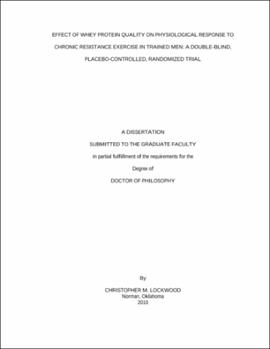| dc.description.abstract | Acute studies have revealed that insulin and possibly incretin hormone [e.g., glucagon-like peptide-1 (GLP-1)] response in humans is significantly affected by whey protein (WP) form [e.g., whey protein isolate (WPI) versus hydrolysate (WPH)], whereas extensive hydrolysates of casein protein, versus native casein, were recently shown to promote a potentially greater (p=0.10) acute muscle protein synthesis response. Similarly, fractions and specific peptides from WP have been identified that may potentiate exercise recovery and/or the muscle protein synthesis response from heavy resistance training. However, to date, no study has compared the chronic effects WP form or molecular distribution may have when consumed in combination with heavy resistance training. PURPOSE: Therefore, the primary purpose of this investigation was to compare the effects of three different variations of a WP on the physiological response to weight training in previously resistance trained, healthy males. METHODS: Fifty-six resistance trained men (21.40±0.36 yrs; 79.46±1.04 kg; 178.59±0.66 cm; 1.24±0.03 1RM bench press-to-body mass ratio) were randomly assigned to receive one of four double-blinded treatments: 30 g/serving carbohydrate (PLA) or 30 g/serving protein from either a) 80% whey protein concentrate (WPC80), b) high lactoferrin containing 80% WPC (WPC80+), or c) extensively hydrolyzed WPC80 (WPH). All subjects participated in eight weeks of a split-body, linear periodized resistance training program, and consumed two servings of treatment per day (one immediately pre- and post-exercise on training days; twice between meals on non-training days). Body composition, upper- and lower-body strength [1RM Bench Press (1RM BP) and 1RM Hack Squat (1RM HS), respectively] and anaerobic endurance [80% of 1RM for maximal repetitions (80RM BP and 80RM HS, respectively)], and fasted blood measures were assessed before (PRE) and after (POST) the 8-week intervention. Twenty-four hour muscle damage (CK) and immune (WBC) response to lower-body resistance training was assessed during Week 1 and 8. Also, total repetitions to failure, CK and WBC were assessed during POST, prior to and in response to repeated daily (x3) bouts of 80RM HS. Two-way repeated measures ANCOVAs were used for statistical analyses. Significance was set at α = 0.05. RESULTS: No significant differences (p>0.05) were observed between groups for total training volume (kg/min), or relative energy (kcals/kg/d), protein (g/kg/d), carbohydrate (g/kg/d), or lipid (g/kg/d) during the 8-week intervention. All groups increased (p<0.0125) 1RM BP (kg), 1RM HS (kg), 80RM BP (reps) and 80RM HS (reps) from PRE to POST, however, no significant (p>0.05) between-group effects were observed. For repeated 80RM HS tests, only WPC80+ realized a significant difference for total repetitions completed between any of the three days of testing (+15.56% more repetitions for 80RM24 versus 80RMPOST; p<0.0125). No significant between- or within-group (p>0.05 and p>0.0125, respectively) changes were observed for 12-hour fasted blood lipids, glucose, WBC or CK from PRE to POST; however, all groups reduced (p<0.0125) creatinine, and WPH creatinine at POST was shown to be significantly different from WPC80+ (-14.218%δ; p<0.05). Urea nitrogen (BUN) was also shown to decrease significantly (p<0.0125) from PRE to POST for WPH (-18.064%), which differed significantly (p<0.05) from WPC80 (+16.908%; p<0.0125). CK response to Week 1 versus Week 8 lower-body exercise, however, decreased significantly in all groups except WPH (-60.327%; p=0.073), and no significant differences occurred between- or within-groups for WBC. Likewise, repeated 80RM HS resulted in no significant between group differences (p>0.05) for either CK or WBC. Lean body mass and total body muscle mass increased (p<0.0125) in all groups, as did body mass in all groups except WPH (+0.641 kg; p=0.114). However, WPH realized a significant PRE to POST reduction in fat mass (-5.942%) and percent body fat (-1.601%), which was significantly different (p<0.05) from PLA (+9.100% and +0.640%, respectively). CONCLUSION: In previously trained, college-aged men, 60 g/d of WPC80, WPC80+, WPH or PLA provide similar responses to an 8-week heavy resistance training program on measures of total body muscle mass, strength, anaerobic endurance and blood lipids. However, WPH appears to significantly augment lipolysis and may increase nitrogen retention. | |
